- Учителю
- Урок по английскому языку на тему 'Австралия' (7 класс)
Урок по английскому языку на тему 'Австралия' (7 класс)
Непейвода Елена Вячеславовна,
учитель английского языка
школа-лицей «Дарын»
Класс: 7 «Б»
г.Петропавловск,
Северо-Казахстанская область, Республика Казахстан
Australia. "Terra Incognita"
Цели урока: формировать у учащихся основополагающие навыки и умения англоязычного общения, создать условия для осознания и осмысления учебной информации, ее применения в новой учебной ситуации.
Задачи урока: -образовательные: закрепить и обобщить знания учащихся по теме «Австралия»: расширить кругозор по англоязычному страноведению, расширить знания об основных фактах истории, географии, природы Австралии; повторить грамматическую тему - Continuous Tenses; активизировать употребление тематической лексики.
-развивающие: развить умения учащихся анализировать и обобщать знания, способствовать развитию коммуникативных умений (аудирования, говорения, чтения, письма); развить языковую память, логическое мышление, внимание, воображение, самостоятельность и самоконтроль и т.д.
-воспитательные: способствовать воспитанию у учащихся духовно-нравственных ценностей, уважение и интерес к культуре других стран.
Здоровьесберегающая задача урока: предупреждать переутомление учащихся путем смены деятельности.
Форма урока: комбинированный урок.
Методы урока:
-
объяснительно-иллюстративный;
-
проблемно-поисковый;
-
элементы игровых технологий.
Тип урока: урок обобщения и систематизации.
Оборудование:
-
дидактический материал;
-
ТСО (экран, проектор, компьютер);
-
мультимедийные технологии.
Procedure
1. Introduction. Brainstorming.
T: Dear pupils, I'm glad to see you again. I'm sure you expect me to tell something extraordinary or special. You're right. We are going to speak about the most mysterious country of the world. I suppose while looking at the pictures you'll guess what country we'll visit.
What can you see in the pictures?
(The teacher shows some pictures on the smart board- Kangaroo, aborigines…)
T: Pupils, have you guessed what country it is? Certainly you're right, it's Australia.
2. Warming up. Microphone.
T: So pupils it's quite clear that the theme of our lesson is Australia. Please, imagine that this is a microphone and try to give answers to my questions. You can answer if you have a microphone, you can't answer without it.
-
What interesting facts do you know about Australia?
-
Do you know any exotic animals in Australia?
-
Have you ever been to Australia?
-
Would you like to go to Australia some day?
3. Main Part
a) Phonetic drill. T: Pupils, look at the blackboard and repeat the following words after me. We will need these words at our lesson today.
Australia
Tasmania
aborigines [æbə 'rɪdʒɪnz]
kangaroo [ ͵kæŋɡə 'ru:]
eucalyptus [ ]
Southern Hemisphere [ 'sʌðə(r)n 'hɛmɪsfɪə]
the Commonwealth [ 'kɔmənwɛlθ]
Kookaburra [ 'kʊkə ,bʌrə]
Adelaide [ 'ædəleɪd]
monarch [ 'mɔnək]
Now make up word combinations or sentences using these words.
c) Listening Comprehension. Watching the Video (3 minutes)
Now you are going to watch a video about Australia. Be very attentive, please, because you will have to do some tasks based on the contents of the video.
"Australia-Location, Boundaries and Physical Divisions" https://www.youtube.com/watch?v=LlJ093rErq0
b) After listening (watching a video). Critical thinking training
T: Say if these statements are True or False with the help of the words:
- I strongly disagree, because…
- I strongly agree…
- You're absolutely right.
- I totally disagree, because…
* Australia is the largest continent of the world;(I strongly disagree, because it's the smallest continent)
* It's official name is Commonwelth of Australia ; (I strongly agree)
* Australia's name is derived from the Latin word "Australis" meaning 'northern'; (I strongly disagree, because it means 'southern')
* Australia is the largest continent in the world; I strongly disagree, because Australia is the sixth largest country in the world)
* In 1603 the Dutch ship sailed along the coast on Northern Australia with a great interest ; (I strongly disagree, because the Dutch ship sailed along the coast on Northern Australia with a little interest)
* In 1642 another Dutch ship captained by James Cook sailed South Australia and discovered the island, now known as Tasmania. ; (I strongly disagree, because the Dutch ship was captained by Abel Tasman)
* The British Government sent a ship led by James Cook to know more about Australia;( I strongly agree that the British Government sent a ship led by James Cook to know more about Australia ;)
* Captain Cook reached the coast of Australia in 1776; (I strongly disagree, because Captain Cook reached the coast of Australia in 1770)
* Australia celebrates its National Day on July 26th; (I strongly disagree, because Australia celebrates its National Day on January 26th.
* Australia lies in the Southern Hemisphere and in the Eastern Hemishhere. ( I strongly agree that Australia lies in the Southern Hemisphere and in the Eastern Hemisphere )
* Australia is bordered by the Indian Ocean in the west and the Pacific Ocean in the East. (I strongly agree that Australia is bordered by the Indian Ocean in the west and the Pacific Ocean in the East)
c) Team work. T: Pupils, please come here. In the box there are puzzles of 2 pictures- these are the animals of Australia, choose one puzzle and you will know what team to join. One team will ask the questions, the other team will answer them. Then you'll change over. I will mark your points on the board in the following way: EACH GRAMMATICALLY CORRECT QUESTION STANDS FOR 1 MAGNET, THE SAME IS FOR YOUR ANSWERS.
Take cards with your tasks:
-
Full name
The Commonwealth of Australia
-
Official language
-
States and territories
6 states, 2 territories
-
Population
18 million
-
Main cities
Melbourne, Adelaide, Perth, Hobart, Brisbane, Darwin
-
Location
the Southern Hemisphere
-
Washed:
the Indian Ocean, the Pacific Ocean;
Physical activities.
e) «Jigsaw reading»
Your teams get different texts containing different information each, but the tables you get are the same. Read your texts very attentively, fill in the gaps with the missing information. Then choose 2 leaders from each of the groups and share the information you have. You will get points for this task as well.
5 minutes for reading and filling in the tables.
Dear guests, now I suggest to you watching a video.
Canberra - is the of . With a population of over 312,000, it is Australia's largest inland and the eighth largest Australian city overall. The city is located at the northern end of the (ACT).
The highest point is at 888 metres (2,913 ft). Other large hills include , , Mt Mugga Mugga and . The surrounding and the original bush land that Canberra was built in is a mixture of eucalyptus , open grassland, , and dry eucalyptus forests.
Canberra has a with four distinct seasons. Canberra experiences hot, quite dry summers, and cold winters with heavy fog and frequent frosts, with a rare spot of snow in the but the surrounding areas get annual snowfall through winter and often the snow capped mountains can be seen from the CBD.
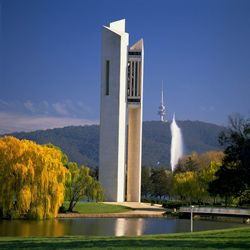
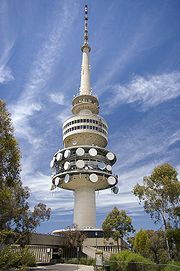
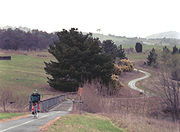

Melbourne - is the capital of state Victoria (population in state - 4645000), the second largest city in Australia.
You'll enjoy traveling around Melbourne on the City Circle Tram. It runs every 10 minutes from 10. a.m. till 6 p.m. While you are sitting on the tram, the conductor will point out the most interesting sights in Melbourne.
Melbourne- is a very multicultural city. Over a quarter of the population was born overseas. It is home to many cultural groups, speaking 170 languages. It is one of the largest Greek and Italian populations in the world. Population of about 1,100,000.
Melbourne enjoys four distinct seasons. Winter with cool night; spring and autumn are delightful. Warm summer. Geologically, it is built on the confluence of .
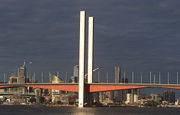
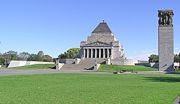

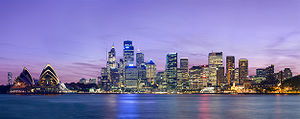
Sydney is the capital of New South Wales (population in state - 6372000). Australia's oldest, largest and industrial city. Nearly a quarter of all Australians live here. Population of about 4,340,000 and growing.
T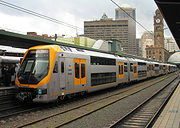 he City of Sydney has a soothing and pleasant climate with warm summers and cool winters. The city does not generally experience extremes of temperature differences but it can only occur under the influence of El Nino current and sudden hailstorms. Bushfires are a major problem in the outskirts of the city, especially during the summer season. The city is also considerably affected by the oceanic influences.
he City of Sydney has a soothing and pleasant climate with warm summers and cool winters. The city does not generally experience extremes of temperature differences but it can only occur under the influence of El Nino current and sudden hailstorms. Bushfires are a major problem in the outskirts of the city, especially during the summer season. The city is also considerably affected by the oceanic influences.
The City of Sydney is bordered by the Pacific Ocean in the east, by Blue Mountains in the west, Hawkesbury River in the north and Woronora plateau in the south. The City of Sydney is known for its wonderful beaches and coastal areas. There are more than seventy harbor areas in the Sydney urban area and Sydney Harbor is the largest natural harbor in the world.
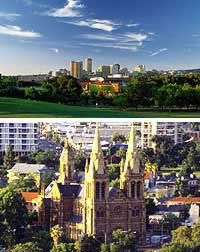 Adelaide- the capital of (population in state 1467000), was planned in 1836, by surveyor Colonel William Light. The city centre has a grid of wide streets and various squares all within 1 square mile. This centre is surrounded by a green belt of 930 hectares of parkland.. The main street, King William Street, runs from north to south through Victoria Square at the heart of the city. The climate is Mediterranean - with hot, dry summers and cool, mild winters. The average winter temperature is around 15C; average for summer is 29C. The Torrens River runs through the centre, separating Adelaide and North Adelaide. The city is surrounded by diverse landscapes, including the Mount Lofty Ranges (Adelaide Hills) and coastal beaches. Population of about 1,100,000.
Adelaide- the capital of (population in state 1467000), was planned in 1836, by surveyor Colonel William Light. The city centre has a grid of wide streets and various squares all within 1 square mile. This centre is surrounded by a green belt of 930 hectares of parkland.. The main street, King William Street, runs from north to south through Victoria Square at the heart of the city. The climate is Mediterranean - with hot, dry summers and cool, mild winters. The average winter temperature is around 15C; average for summer is 29C. The Torrens River runs through the centre, separating Adelaide and North Adelaide. The city is surrounded by diverse landscapes, including the Mount Lofty Ranges (Adelaide Hills) and coastal beaches. Population of about 1,100,000.
Brisbane - is the state of (population in state- 3655000) and its most populous city. It is also the in , behind southern rivals and . The city is situated on the on a low-lying between and the in Queensland. The city of Brisbane is hilly. Brisbane has a with hot, humid summers and dry, mild winters. Tropical climate makes it a year-round vacation place. Population of about 1,400,000.
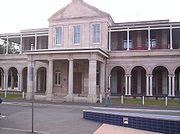


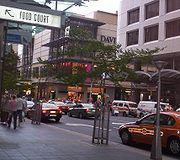

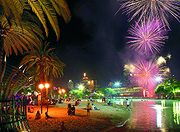
Darwin, named after the famous naturalist, Charles Darwin, is Australia's most northernmost state capital-( North Territory-population 211000). Its tropical climate and proximity to Australia's northern neighbours has attracted many Asian immigrants, which in turn has helped turn this once rough-and-ready frontier town into a multi-cultural city beside the sea. Population of about 70,000. Darwin is dominated by two distinct seasons. The wet season, known locally as 'The Wet', runs roughly from early November to the end of March, and the dry season, or 'The Dry', which generally lasts from April to October. Darwin is the 'gateway' to the world-famous Kakadu National Park, the gorgeous Litchfield National Park, dramatic Katherine Gorge, and the red crags of the Kimberley region.
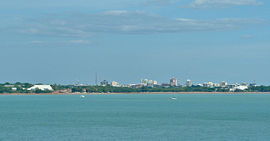

Hobart is the and most populous city of the island state of (population of state of Tasmania is 457000). Founded in 1803 as a , Hobart is Australia's second oldest capital city after . The city is the financial and administrative heart of Tasmania, and also serves as the home port for both Australian and French operations.Population of about 200,000. Hobart has a mild temperate with four distinct . The highest maximum temperature recorded was 40.8°C on 4 January 1976 and the lowest minimum was -2.8°C on 25 June 1972. The city rarely receives snow during winter, the adjacent Mount Wellington is often seen with a covering. Unseasonal mountain snow covering has been known to occur during all seasons. Though snow is unusual in general at sea level in Australia, Hobart has most probably had the most sea level snowfalls out of any State Capital, though , and have also recorded snow.
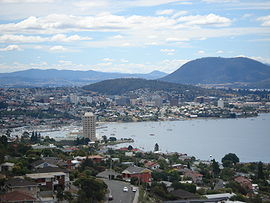
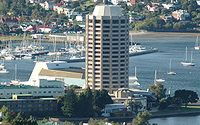
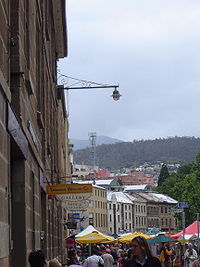
Perth - is the capital of state of Western Australia (population in state is 1851000). Population of about 200,000. Perth ranks fourth amongst the nation's cities, with a growth rate consistently above the national average. Perth is one of the most isolated metropolitan areas on Earth. The nearest city to Perth with a population over 1 million is in , which is 2,104 kilometers (1,307 mi) away.
Perth is set on the Swan River. The city centre and most of the suburbs are located on the sandy and relatively flat , which lies between the and the Indian Ocean. The soils of this area are quite infertile. Summers are generally hot and dry, lasting from late December to late March, with February generally being the hottest month of the year, making Perth a classic example of a . Winters are relatively cool and wet, with most of Perth's annual rainfall falling between May and September.

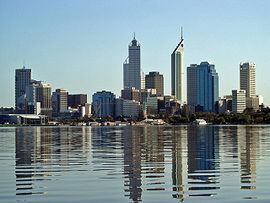
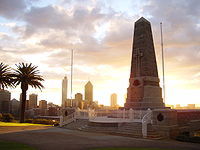
Приложение.
f) Fill in the table.
Cities
State
Population in the state
Population in the city
Geography
Climate
Canberra
ACT
340,000
312,000
Hilly, , eucalyptus , grassland, , and dry eucalyptus forests.
M, hot, quite dry summers, and cold winters with heavy fog and frequent frosts, with a rare spot of snow
Melbourne
Victoria
4,645,000
1,100,000
.
Four distinct seasons. Winter with cool night; spring and autumn. Warm summer.
Sydney
NSW
6,372,000
4,340,000
The Pacific Ocean in the east, by Blue Mo-untains in the west, Hawkes-bury River in the north and Woro-nora plateau in the south.
Soothing and pleasant climate with warm summers and cool winters.
Adelaide
SA
1,467,000
1,100,000
The Torrens River runs through the centre, separating Adelaide and North Adelaide. The city is surrounded by diverse landscapes.
Mediterranean - with hot, dry summers and cool, mild winters.
Brisbane
QSL
3,655,000
1,400,000
Low-lying .
H with hot, humid summers and dry, mild winters.
Darwin
NT
211,000
70,000
Australia's most northernmost state capital.
Tropical climate: two distinct seasons, the wet & dry seasons.
Hobart
Tasmania
457,000
200,000
Mountains, hills.
Mild temperate with four distinct .
Perth
WA
1,851,000
200,000
The sandy and relatively flat.
Summers are hot and dry, winters are cool and wet.
Таблица заполнена для учителя, для учеников - только название городов.
g) True-False.
a) Sydney is the capital of Australia. -
b) The biggest Australian state is Queensland. -
c) The biggest state is New South Wales. +
d) Darwin, named after the famous naturalist, Charles Darwin, is Australia's most northernmost state capital. +
e) Sydney is the capital of New South Wales Australia's oldest, largest and industrial city. Nearly a quarter of all Australians live here. +
3) Complete the sentences.
a) Canberra has a with four distinct _______. (seasons)
b) Melbourne - is the capital of state Victoria, the _______ largest city in Australia. (second)
c) _______ are a major problem in the outskirts of the city, especially during the summer season. (bushfires)
d) The center of Adelaide has a grid of wide streets and various ______ all within 1 square mile. (squares)
e) The city of Brisbane is _____. (hilly)
f) Darwin is dominated by ____ distinct seasons. (two)
g) Hobart is Australia's second oldest capital city after ______. (Sydney)
h) ____ is one of the most isolated metropolitan areas on Earth. (Perth)
4. Dear pupils, our lesson is coming to its end. We've worked very hard. We've learnt a lot of useful information about Australia. Probably you'll use it at your geography and history lessons. I'll be glad if you are a success. To summarise what we've learnt I've prepared some exercise for you. So, we are going to revise everything that you know about Australia. (quiz- see PRESENTATION)
Feedback. (See PRESENTATION)
T: Pupils, your home assignment is to make a mini project - 1. On the sheet of paper you express all your knowledge and impressions of the theme Australia. 2. Recite 10 sentences about Australia.
Dear pupils, thank you for being so hard-working and persistent. Our lesson is over.
9